Contact:
Lane Smith, Research Program Coordinator, NYSG, E: lane.smith@stonybrook.edu, P: (631) 632-9780
Stony Brook, NY, April 19, 2021 - For 50 years, New York Sea Grant (NYSG) has been supporting university-based research related to a variety of marine, Hudson estuary, and Great Lakes topics and issues.
Here are some summaries for recently-completed investigations that address a variety of concerns within a few key topics, including:
(a) Coastal Ecosystems — exploring impacts of low dissolved oxygen levels, harmful algal blooms, bacterial contamination, microplastics, ocean acidification
(b) Fisheries — examining fish habits via tagging; how will populations adapt to future environmental changes, climate change; restoring historic migratory fish runs
(c) Coastal Communities — resiliency in the face of risks to property and infrastructure from climate change

Summer flounder are masters of camouflage, but can they hide from ecological pressures over time along the U.S. East Coast? NYSG-funded researchers at Stony Brook University studied water temperature impacts on summer flounder biology to assess potential impacts of changing climate. Image credit: Chris Paparo/@fishguyphotosImpacts
Impacts of Climate Change on the Distribution, Population Connectivity, and Fisheries for Summer Flounder (Paralichthys Dentatus) in the Mid-Atlantic (R/MARR14NJ-NY, Drs. Janet Nye and Hyemi Kim, Stony Brook University)
How fish populations will adapt to climate change is a challenge facing fisheries managers. As part of a Mid-Atlantic Sea Grant regional project, a research team at Stony Brook University led by Dr. Janet Nye (now at University of North Carolina) examined the role that increased water temperature has on the biology of the economically important summer flounder. Results showed that there was a small, but significant effect of temperature on fish distribution, age-specific natural mortality and recruitment. This work demonstrates the relative importance of seawater temperature on summer flounder life history and can inform the future management of the stock.
More:
Using Oceanography to Track Fish Populations (September 2020)
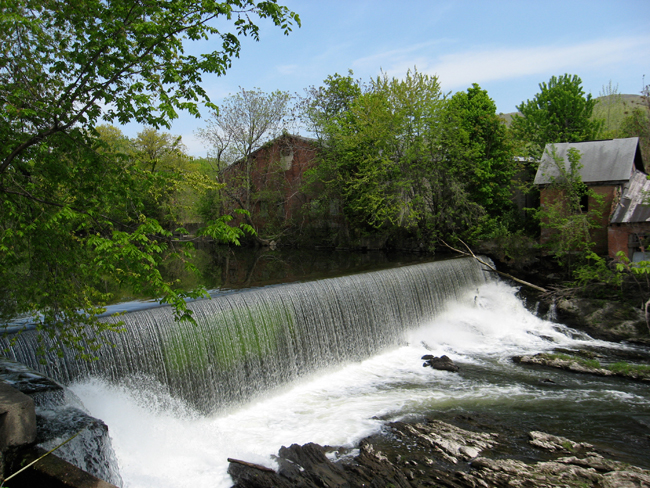
NYSG-funded researchers at SUNY-ESF studied methods to engage communities considering dam removal to restore migratory fish runs. Image credit: Joseph A., Flickr
Reconnecting Waters for Eels and River Herring: A Mediated Modeling Approach to Assess Receptivity to Dam Removal in the Hudson-Mohawk Watershed (R/FHD-14, Drs. Karin Limburg and Andrea Feldpausch-Parker, with graduate student Kayla Smith, SUNY-ESF; Dr. Alexander Smith, New York State Department of Environmental Conservation)
In the Hudson River watershed and elsewhere in New York, there is growing interest in removing small derelict dams in order to restore historic migratory fish runs (e.g. river herring and the American eel). A SUNY-ESF and NYSDEC research team led by Dr. Karin Limburg employed different educational methods to help community groups asses the “barriers and bridges” to dam removal. The participation of stakeholders in field trips, workshops and interviews proved invaluable to improved understanding of community-level interest, concerns, priorities, and tradeoffs regarding dam removal. Using this approach can help communities prioritize management actions and will ultimately help to inform state-level decision making for dam removal projects that benefit people and biodiversity.
More:
New York Sea Grant Research: Results and Impacts (March 2020)
New York Sea Grant Announces New Omnibus Research Projects (Summer 2016)
Marine Science Experts Discuss Eel Aquaculture Partnership (November 2014)
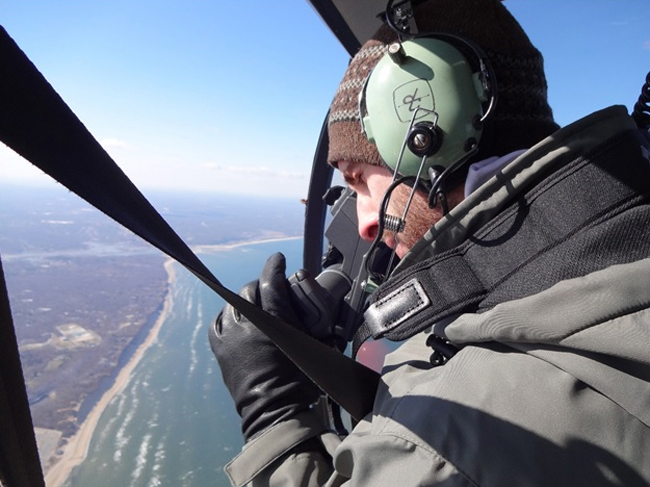
While we cannot see submarine groundwater discharge, Stony Brook University researchers have captured photographic evidence of it via a thermal infrared camera, later combining this with measurements from the ground. Image credit: Joseph Tamborski
The Role of Submarine Groundwater Discharge in Promoting Hypoxia in Smithtown Bay (R/CMC-12, Drs. Henry Bokuniewicz, J. Kirk Cochran, and A. Deanne Rogers, Stony Brook University)
The occurrence of very low dissolved oxygen levels (hypoxia) is a perennial problem in many coastal embayments in Long Island Sound (LIS). Excess nutrient loading in our coastal waters is the major factor contributing to hypoxia by fueling plankton blooms that result in oxygen consumption by microbial decomposition of the bloom when it dies and sinks to the sediments. A research team led by Dr. Henry Bokuniewicz at Stony Brook University used thermal infrared camera technology coupled with on the ground measurements, to measure a little appreciated source of nutrient input into a local LIS embayment, Smithtown Bay. This source is known as submarine groundwater discharge (SGD) – a hydrological process commonly occurring in coastal areas that consists of upwelling freshwater, re-circulated seawater, or a composite thereof. The results of the project documented the importance of nutrient input into Smithtown Bay from SGD. For example, the results show that fresh SGD accounts for inputs approximately equivalent to the discharge of the Nissequogue River with saline SGD fluxes even greater. These results demonstrate the need to consider SGD sources when managing nutrient inputs for improved water quality.
More:
A Chemical Clock to Study Coastal Water Quality (February 2020)
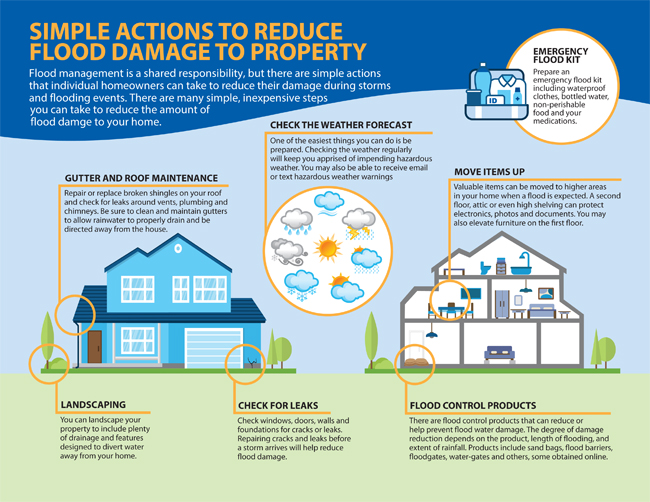
Being resilient before a coastal storm is key, which is why New York Sea Grant has produced a new fact sheet series that starts with "Simple Actions to Reduce Flood Damage to Property" (pdf) and continues with "Options to Reduce Flood Risk to Your Home" (pdf). There are also two companion one-pagers with Resources for Homeowners (pdf) as well as Resources for Municipalities (pdf).
Increasing Coastal Resilience Through Facilitated Zoning Code Assessment and Amendment (R/CHD-10, Dr. John Nolon, Ms. Jessica Bacher, Ms. Tiffany Zezula, Pace University)
Coastal communities in NY State and throughout the nation are facing increasing risks to property and infrastructure from climate change including sea level rise, flooding events, severe storms, and ocean acidification. A research team led by Jessica Bacher, John Nolan and Tiffany Zezula at Pace University’s Land Use Law Center (LULC) developed and implemented decision-support tools and trainings to facilitate coastal communities’ efforts to assess and amend their zoning codes to increase their resilience. A product developed from the project was a set of example annotated model codes for use by coastal communities, which is publicly accessible on the LULC’s web site. The trainings and tools were specifically designed to help address the need for coastal storm and sea level rise (SLR) preparedness on Long Island.
More:
Zoning Law Changes Build Coastal Resiliency (September 2020)

Stony Brook University investigators study harmful algal bloom dynamics (like this rust tide in Orient Harbor) and possible impacts on Long Island shellfisheries. Image credit: Peconic Estuary Partnership
Assessing Bloom Dynamics of the Toxic Dinoflagellate, Cochlodinium Polykrikoides and Impacts on Fisheries: Are There Mitigation Options? (R/CMB-40, Drs. Christopher Gobler and Ying Zhong, Stony Brook University; Dr. Sandra Shumway, University of Connecticut)
The red tide forming dinoflagellate Cochlodinium polykrikoides has been responsible for fish and shellfish kills in NY coastal waters. Within the last couple of decades, the U.S east coast has experienced an increase in significant blooms. Management and mitigation of red tide blooms has been hampered by a lack of knowledge of red tide bloom dynamics. A research team led by Dr. Christopher Gobler at Stony Brook University conducted a study to address this knowledge gap. The research team conducted field surveys measuring horizontal and vertical distribution and migration during bloom development. The project team also conducted experiments to assess the growth and survival of shellfish under bloom conditions in both the field and laboratory. Project results revealed that cell densities during Cochlodinium blooms are greatest at surface layers. Accordingly, it was found that shellfish nets deployed at the surface experienced significantly more mortality than individuals deployed at depth. This work has benefit to the aquaculture industry, demonstrating that to reduce mortality during bloom events shellfish can be placed at greater depths.
More:
Rust Tides Do Harm Shellfish ... But Research Offers Promise for Shellfish Farmers (September 2020)
State of the Bays: Noxious Seaweed Among New Threats in 2020 (August 2020)
Reporting Suspicious Marine Algal Bloom (May 2020)
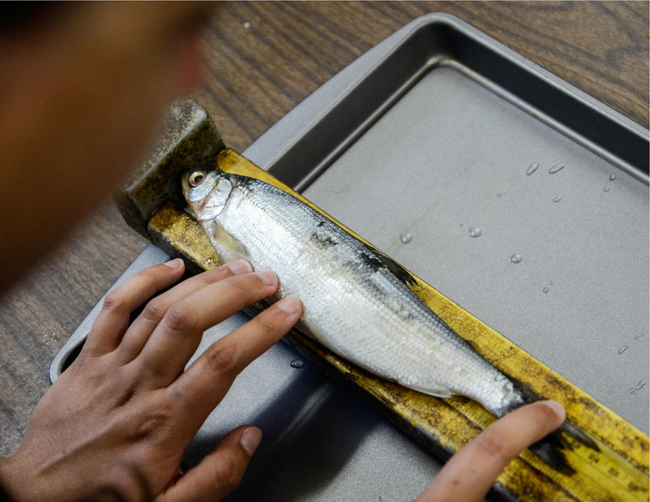
Cisco, the focus of a Cornell University-led project, was once a commercially and ecologically important fish in Lake Ontario. The study described the genetic diversity of cisco populations to inform restoration efforts. Image credit: Heather Ainsworth
Identifying Genetic and Habitat Limitations to Cisco Restoration in Lake Ontario (R/XG-23, Drs. Matt Hare and Lars Rudstam, Cornell University; Dr. Darran Crabtree, The Nature Conservancy)
Cisco (Coregonus artedi) was once a commercially and ecologically important fish in Lake Ontario, before declining in the late 1800’s and early 1900’s due to overfishing, habitat degradation, and competition from invasive species. Interest in restoring cisco populations in Lake Ontario is growing, as it forms an important part of the native food web. However, there is concern about the genetic robustness and adaptability of cisco due to their low population size. There are questions about the level of genetic diversity and connectedness between populations, and their ability to adapt to different environmental changes. A study led by Dr. Matthew Hare at Cornell University compared the genetic diversity of several aggregations of cisco across Lake Ontario. The project results documented high genetic diversity and connectedness across Lake Ontario populations. The results suggest that cisco in Lake Ontario have the capacity to adapt to future environmental changes and to benefit from restoration efforts throughout the lake.
More:
The Cisco, Perhaps the Biggest Little Fish, Could Make its Comeback (February 2020)

Located near Buffalo, New York, Buffalo Harbor State Park includes the Gallagher Pier — a 1,400-foot scenic shorefront popular with local and regional residents that was also the scene for a recent SUNY Buffalo State-led study. Image credit: Office of Congressman Brian Higgins
Impact of Point and Non-Point Sources on Indicator Bacteria Loading at the Gallagher Pier Area of Buffalo Harbor State Park (Erie County, NY) as Determined by Next Generation Sequencing (R/XG-27, Drs. Gary Pettibone and Amy McMillan, SUNY Buffalo)
Located near Buffalo, New York, the recently established Buffalo Harbor State Park includes the Gallagher Pier, a 1,400-foot scenic shorefront that is popular with local and regional residents. The area draws kayakers and windsurfers and would be ideal for bathing, except for the presence of high bacteria levels that keep the area closed to swimming. Beach closings due to high indicator bacteria levels are common for the area during the summer months. The main source believed to contribute to the high bacterial counts is a 36-inch storm drain near the beach. Traditional scientific tests of indicator bacteria counts are not able to determine the sources of bacterial contamination. A research team consisting of Dr. Gary Pettibone and Dr. Amy McMillan of SUNY Buffalo State used Next Generation Sequencing (NGS) of the 16S rRNA gene to determine the source of high beach bacterial levels. They found that the bacterial community from the storm water outfall is distinct from the community located near the beach and likely does not contribute to the high bacterial counts there. The results demonstrate that this technique is a useful tool to help determine the origins of bacterial contamination.
More:
Scientists Use Innovative Genetic Methods to Locate Sources of Pollution, Contamination (April 2018)
On Air: NYSG-funded Scientists study DNA to find pollution source in Great Lakes (August 2016)
NYSG Awards Buffalo State Researchers Nearly $12K to study water at Gallagher Pier (August 2016)

Plastic particles (inset) float within a stream sample like the one Dr. Sherri Mason took while being interviewed by Al Jazeera America in July 2014. Credit: Nick Gunner; (inset) Sherri Mason.
Determining Degradation Rates, Products and Impacts for Prominent Plastics in Freshwater Environs (R/CTP-53, Drs. Sherri Mason and Courtney Wigdahl-Perry, SUNY at Fredonia; Dr. Joseph Gardella, Jr., University at Buffalo)
Recently, there has been growing concern over microplastics (plastic particles <5 mm in diameter) and their impacts in the Great Lakes. Studies have shown that most microplastic particles are small enough to be ingested by plankton and other filter feeders that form the base of lake food webs. These particles adsorb contaminants from the water and once ingested these plastics can serve as a source of organic contaminants up the food chain. A research team led by Dr. Sherri (Sam) Mason of SUNY Fredonia (now at Penn State, Behrend) conducted a chemical analysis of microplastics obtained from Lake Erie water samples. The team also conducted laboratory-feeding studies using a model zooplankton organism (Daphnia magna) to determine growth and survival rates with microplastics in their feed. Results showed that filter-feeding cladocerans consume microplastics that are the size of natural prey items and that their feeding and growth were negatively impacted. In addition, chemical analysis showed that these particles have organic pollutants adsorbed onto their surface. Results suggest that microplastics may be consumed if encountered in freshwater environments and introduce organic pollutants into the food chain.
More:
Tiny organisms in the water eating plastic: Could it harm us all? (April 2020)
Plastics floating in the water: What are the risks? (April 2020)
Plastics —"We're The Problem, But We're The Solution. Be The Change" (April 2020)
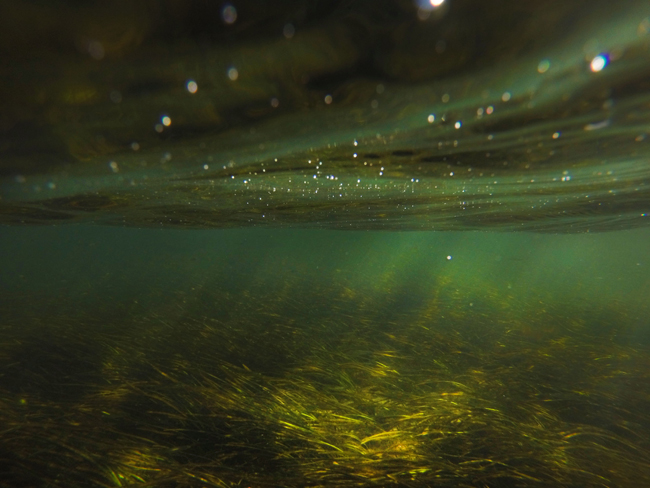
Stony Brook University investigators report that seagrasses may provide refugia — areas of more favorable conditions for bivalve species (oysters, clams, mussels and scallops) — from the surrounding acidified waters. Image credit: Kaitlyn O’Toole
Impacts of Climate Change and Ocean Acidification on Economically Important Shellfish in New York: Are There Effective Mitigation and Adaptation Measures? (R/FBM-38, Dr. Christopher Gobler, Stony Brook University)
Climate change is having important impacts on coastal marine environments, including rising temperatures and carbon dioxide levels that are contributing to low oxygen levels and ocean acidification. Many resident populations of ecologically and economically important fish and shellfish species are already experiencing stressful levels of pH, dissolved oxygen (DO), and temperature. A research team led by Dr. Christopher Gobler at Stony Brook University conducted field and laboratory analyses to study the impacts of temperature, DO and acidification on shellfish. Laboratory results showed that acidification and hypoxia can significantly impair the normal development, growth, respiration, and survival among early life stage bivalves and these conditions together have a greater negative impact than either do separately. An additional component of the research showed that seagrasses might provide refugia for shellfish from the surrounding acidified waters. Researchers also identified a cost-effective method of treating water with sodium carbonate for hatcheries impacted by acidified seawater. Facility technicians could rapidly increase pH levels in their source water to allow for adequate larval survival.
More:
Refuge Areas Could Protect Prized Fisheries in a Changing Climate (February 2020)

Cornell University investigator James Watkins (in green t-shirt) attaches a pop-off satellite archival tag to a salmon offshore of Oswego, NY in mid-July 2017 with the assistance of charter boat captain Ernie Lantiegne and researcher Chris Perle (Florida State College). These tags tracked the movements of salmon in Lake Ontario. Image credit: Chris Marshall
Vertical Habitat of Salmonids in Lake Ontario Using Archival Tags and Hydrodynamic Models (R/FBF-24, Drs. Lars Rudstam, and James Watson, Cornell University; Christopher Perle, Florida State College)
Due to their economic and ecological importance, understanding king salmon movements and biology is important for fishery biologists and state agencies to manage the fishery. A research team Led by Dr. Lars Rudstam of Cornell University tracked movements of mature king salmon within Lake Ontario and its tributaries using pop-off satellite archival tags (PSATs). The tags recorded depth, temperature, light conditions, and acceleration every second to reconstruct individual movement and behavior. The results of the project have provided detailed movement data that have elucidated how salmon use the habitat and the fine-scale temperature data collected from the tags contributed to current salmon bioenergetic models. This information has helped fishery biologists with management of the stock. Additionally, testing has helped Wildlife Computers develop a new line of tags usable in freshwater environments. The collaborations with charter boat businesses during the study have helped disseminate information on salmonid behavior, thereby enhancing the client angling experience.
More:
Electronically Monitoring Salmon Could Help Us To Better Understand Them (April 2020)
More Info: New York Sea Grant
New York Sea Grant (NYSG), a cooperative program of Cornell University
and the State University of New York (SUNY), is one of 34 university-based
programs under the National Oceanic and Atmospheric Administration’s
National Sea Grant College Program.
Since 1971, NYSG has represented a statewide network of integrated
research, education and extension services promoting coastal community
economic vitality, environmental sustainability and citizen awareness
and understanding about the State’s marine and Great Lakes resources.
Through NYSG’s efforts, the combined talents of university scientists
and extension specialists help develop and transfer science-based
information to many coastal user groups—businesses and industries,
federal, state and local government decision-makers and agency managers,
educators, the media and the interested public.
The program maintains Great Lakes offices at Cornell University, SUNY
Buffalo, SUNY Oswego and the Wayne County Cooperative Extension office
in Newark. In the State's marine waters, NYSG has offices at Stony Brook
University in Long Island, Brooklyn College and Cornell Cooperative
Extension in NYC and Elmsford and Kingston in the Hudson Valley.
For updates on Sea Grant activities: www.nyseagrant.org has RSS, Facebook, Twitter, Instagram, and YouTube links. NYSG offers a free e-list sign up via www.nyseagrant.org/nycoastlines for its flagship publication, NY Coastlines/Currents, which is published quarterly.